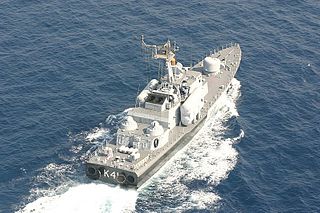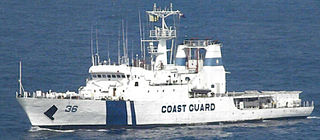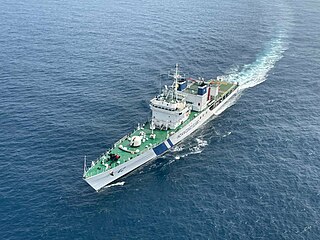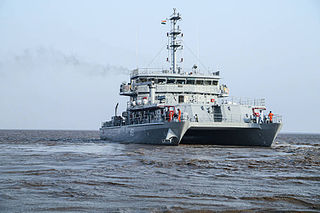
INS Viraat was a Centaur-class light aircraft carrier of the Indian Navy. INS Viraat was the flagship of the Indian Navy until INS Vikramaditya was commissioned in 2013. The ship was completed and commissioned in 1959 as the Royal Navy's HMS Hermes, and decommissioned in 1984. She was sold to India in 1987. INS Viraat was commissioned into the Indian Navy on 12 May 1987, and served for almost 30 years.

The Indian Navy is the maritime branch of the Indian Armed Forces. The President of India is the Supreme Commander of the Indian Navy. The Chief of Naval Staff, a four-star admiral, commands the navy. As a blue-water navy, it operates significantly in the Persian Gulf Region, the Horn of Africa, the Strait of Malacca, and routinely conducts anti-piracy operations and partners with other navies in the region. It also conducts routine two to three month-long deployments in the South and East China seas as well as in the western Mediterranean sea simultaneously.

INS Sindhurakshak was a Russian-made Kilo-class 877EKM (Sindhughosh-class) diesel-electric submarine of the Indian Navy. Commissioned on 24 December 1997, it was the ninth of the ten Kilo-class submarines in the Indian Navy. On 4 June 2010, the Indian Defence Ministry and Zvezdochka shipyard signed a contract worth US$80 million to upgrade and overhaul the submarine. After the overhaul, it returned to India from Russia between May and June 2013.

The Talwar-class frigates or Project 11356 are a class of stealth guided missile frigates designed and built by Russia for the Indian Navy. The Talwar-class guided missile frigates are the improved versions of the Krivak III-class frigates used by the Russian Coast Guard. The design has been further developed as the Admiral Grigorovich-class frigate for the Russian Navy. Six ships were built in two batches between 1999 and 2013.

PNS/M Ghazi (S–130), SJ, was a Tench-class diesel-electric submarine, the first fast-attack submarine in the Pakistan Navy. She was leased from the United States Navy in 1963.

The Nilgiri-class frigates were updated versions of the Leander class, designed and built for the Indian Navy by Mazagon Dock Limited in Mumbai. Six ships were built between 1972–81. Vessels of the class formed the 14th Frigate Squadron. The lead ship INS Nilgiri was the first major warship to be built in India and was built in collaboration with Yarrow Shipbuilders of the United Kingdom.

The Saryu class of offshore patrol vessels (OPV) are advanced patrol ships of the Indian Navy built at the Goa Shipyard Limited. These vessels are capable of ocean surveillance and monitoring and can maintain control of shipping lanes. They can also be deployed to provide security to offshore oil installations, and other naval assets.

The Abhay-class corvettes of the Indian Navy are the customised variants of the Soviet Pauk-class corvettes. The class was primarily intended for coastal patrol and anti-submarine warfare. The last ship of the class is expected to be decommissioned by 2025. The class is being replaced by Arnala-class and Mahe-class of Anti-Submarine Warfare Shallow Water Craft. The ships formed the 23 Patrol Vessel Squadron of the Indian Navy.

The Veer-class corvettes of the Indian Navy are a customised Indian variant of the Soviet Tarantul class. They form the 22nd Missile Vessel Squadron.

The Sandhayak-class survey ships are a series of eight vessels built by Garden Reach Shipbuilders and Engineers (GRSE), Kolkata and Goa Shipyard, Ltd., Vasco for the Indian Navy. While Sandhayak, Investigator, Nirdeshak, Nirupak were built in GRSE; Sarveshak, Jamuna, Darshak, Sutlej were built by Goa Shipyard. The vessels equipped with four survey motorboats, two small boats and are powered by two diesel engines with a top speed of 16 knots. They have a helicopter deck and are also armed with a Bofors 40 mm/60 gun mount for self-defense.

Vikram-class offshore patrol vessels are series of nine watercraft jointly built by Mazagon Dock Limited Mumbai and Goa Shipyard Limited, Vasco da Gama, Goa for the Indian Coast Guard.

Samar class of offshore patrol vessels are series of five ships built by Goa Shipyard Limited, Vasco da Gama, Goa for the Indian Coast Guard.

The Indian Navy has been focusing on developing indigenous platforms, systems, sensors and weapons as part of the nation's modernisation and expansion of its maritime forces. As of January 2025, the Indian Navy had 64 vessels of various types under construction including destroyers, frigates, corvettes, conventional-powered and nuclear-powered submarines and various other ships. It plans to build up to a total of 200 vessels and 500 aircraft by 2050. According to the Chief of the Naval Staff's statement in December 2020, India has transformed from a buyer's navy to a builder's navy.

Torpedo trials craft are primarily naval auxiliaries used by navies for the development of new naval torpedoes and during practise firings. These craft are designed to track and monitor the torpedo and to be able to locate and retrieve the spent torpedo for analysis, and refurbishment for reuse. Torpedo trials craft had their greatest use during the years around World War II when the torpedo was the primary anti-ship weapon of submarines, destroyers and naval aircraft.

INS Astradharini is an indigenously designed and built torpedo launch and recovery vessel built by Shoft Shipyard for the Indian Navy. She was commissioned into Navy Service on 6 October 2015 at the Naval Base in Visakhapatnam. After her commissioning, the ship joined the Eastern Naval Command.















